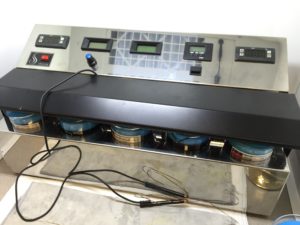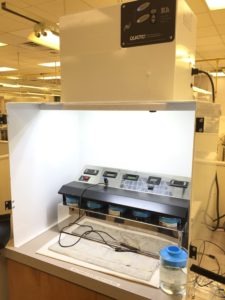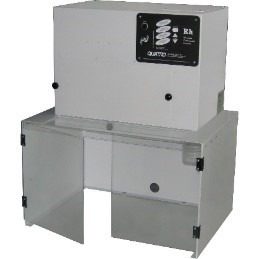What tools do you guys use in your manufacturing? This is the #1 question we get asked. You want to know. And we’re excited to share. At Stuller, we don’t give out the “tried & tested” stamp (the one you’ve probably seen in our recent tools catalogs and on Stuller.com) that easily. Those products have to prove themselves first.
Our manufacturing experts work with a wide range of tools and equipment every day. They have strong opinions and suggestions – rightly so with more years of experience than we’re able to tally. We rely heavily on their advice when choosing which new products get added to our line. These items are extensively tested in actual manufacturing scenarios both real-time and lab settings. We bang them up and push them to their limits daily. That way you know if they make the team, they’ve got to be good.
January is synonymous with repair. In fact, 25% of your total sales will be generated from repair jobs this month alone. So, in conjunction with our Repair campaign on Stuller.com, we will be showcasing a Stuller Tried & Tested series. See our associates use many of your favorite products, learn more about each, and why they’ve earned our seal of approval.
C’mon, let’s get plating!
Bath Plating
 As a jeweler, you know there are many tools used for plating, but do you want to know what Stuller uses?
As a jeweler, you know there are many tools used for plating, but do you want to know what Stuller uses?
For bath plating in our smaller work cells, we use a 5-beaker stainless steel plating unit (45-4020). We like using this unit because it saves us space and it’s very practical. It has everything built in, all you need to do is add the rhodium plating solution. With this unit, you don’t have to worry about buying the burners, rectifier, beakers, and anodes separately, they are
already a part of the unit, and if you need replacement parts, we’ve got those too. Rhodium sold separately.
This unit contains:
- Five 600ml plating beakers
- Two heating elements
- A digital controller
- A sensor thermocouple
- A digital timer, and anodes
- Covers for the beakers
We offer a smaller version of this unit that comes with 2-600 ml beakers, a heating element, a digital controller, sensor thermocouple, digital timer and anode. It also has a cover for the beakers when you’re not using them.
If you need replacement parts for this unit, whether it’s beakers, heating elements, or digital controller, give our Tools Tech Line a call at ext. 4300 and they’ll be happy to help!
 As you can see from these images, we have the unit inside
As you can see from these images, we have the unit inside
a containment hood by Quatro (47-6010) to eliminate odor, vapors, and particles that migrate throughout the work space. We love this hood because it’s small and operates 24/7 allowing the beakers to stay inside the contained area. The width is less than 3 feet. Another plus: it’s very quiet and does not need to be ducted to the outside.
Shop Set Up: Where’s the best place to set up a plating unit? Many customers have told us they set it up in the bathroom  because it has good ventilation. Ha! Clever! But since rhodium is your final step in completing a piece, we suggest setting up your unit between the polishing and the steaming equipment. And, if you go with this Quatro hood, you don’t need to connect it to the outside. Filters on the hood need to be replaced between 3 and 6 months, but may last a bit longer depending on usage.
because it has good ventilation. Ha! Clever! But since rhodium is your final step in completing a piece, we suggest setting up your unit between the polishing and the steaming equipment. And, if you go with this Quatro hood, you don’t need to connect it to the outside. Filters on the hood need to be replaced between 3 and 6 months, but may last a bit longer depending on usage.
Important tips:
- When using this product, stick to the instructions on the rhodium plating bottle – trust us, it’s for the best.
- To get the best results, make sure your piece is clean. Use electroclean (45-2020) before you plate.
- Remember to label your beakers. OSHA requires it.
- To get a good plating on silver, leave the unit on and let it heat to a steady temperature of 98° F.
Pen Plating
For small touch-ups, and pieces that don’t need to be soaked in a rhodium bath, we use the Samson Economy Pen Plater (45-4000). This small machine has withstood the test of time. With proper care, it could last you many years. It has and 18 gauge piano wire, which means it is stronger and has more conductivity compared to a regular wire. It’s a two amp that employs the latest in technology for reliable results.
Important tips:
- Always soak the pen for about 5 to 10 minutes to get a nice tip.
- Start at 7.5 volts.
- Put the alligator clip as close to the area you are plating as possible.
 Even if you have a fume hood connected to the outside, it may be possible for others to come in contact with the harmful fumes. A good solution to protect yourself and others is the ductless fume hood from Quatro (47-3085). This is another rhodium hood that’s been Stuller Tried and Tested. It recirculates fresh air back into the room. This hood is exactly what you need if it’s difficult for your shop to access an outside wall, or if you’re not allowed to drill into the wall. It effectively removes all toxic-plating fumes. And has a three-stage filtering process. The tabletop stand for the Quatro fume hood (47-4101) is sold separately.
Even if you have a fume hood connected to the outside, it may be possible for others to come in contact with the harmful fumes. A good solution to protect yourself and others is the ductless fume hood from Quatro (47-3085). This is another rhodium hood that’s been Stuller Tried and Tested. It recirculates fresh air back into the room. This hood is exactly what you need if it’s difficult for your shop to access an outside wall, or if you’re not allowed to drill into the wall. It effectively removes all toxic-plating fumes. And has a three-stage filtering process. The tabletop stand for the Quatro fume hood (47-4101) is sold separately.
Do you own any of these tools? How are they working for you? Let us know in the comment section below.